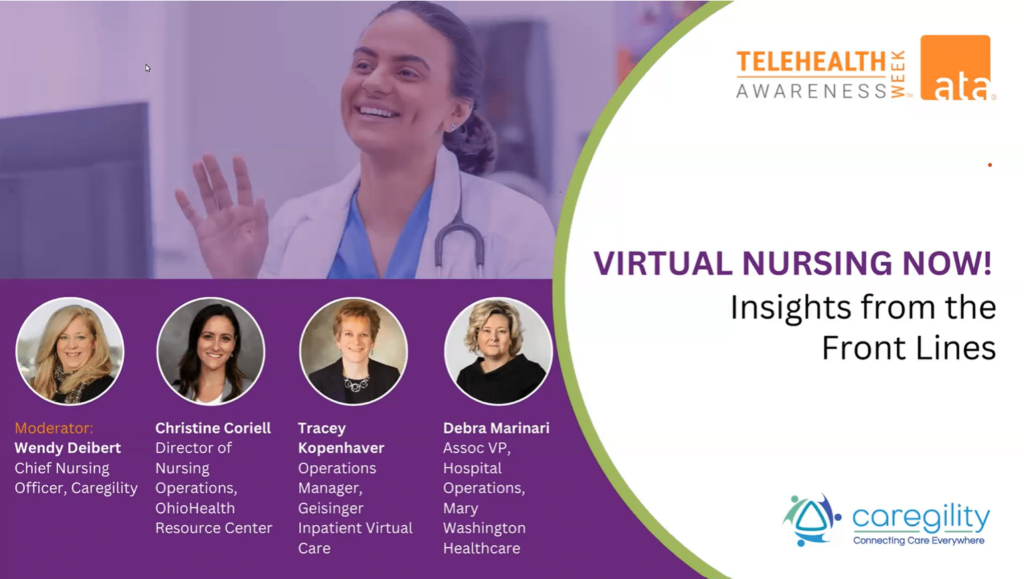Hospital Leaders Weigh in on Virtual Nursing
Healthcare delivery is undergoing a transformation and virtual nursing is at the forefront. In a recent webinar co-hosted by Caregility and the American Telemedicine Association (ATA), healthcare leaders from institutions at various stages of implementing Virtual Nursing programs gathered to discuss their experiences.
Virtual care pioneer and Caregility CNO Wendy Deibert led the illuminating panel discussion featuring Tracey Kopenhaver, Operations Manager, Geisinger Inpatient Virtual Care; Christine Coriell, Director of Nursing Operations, OhioHealth Resource Center; and Debra Marinari, Associate Vice President, Hospital Operations, Mary Washington Healthcare.

Here are some key takeaways from the discussion:
Adoption Drivers
All panelists pointed to nursing workforce challenges as key motivators to pursue Virtual Nursing, but technology and ROI had to line up.
Addressing Nursing Shortages and Burnout
The virtual nursing model allows healthcare organizations to tackle staffing shortages and burnout by distributing the workload more evenly.
“We were motivated by a few things – primarily the nursing shortage, nurse turnover, nurse burnout, and really looking at our care team redesign. Looking at current state, where we don’t have quite enough nurses to go around, and our nurses are overworked and busy and can’t get to all the things that they need to do in a day… How can we try to future-proof or buffer that?” – Tracey Kopenhaver
Technology Aligns with Strategic Goals
By leveraging existing technology that supports remote patient observation teams and tele-ICU programs, Virtual Nursing programs align well with strategic goals to centralize and scale virtual care.
“When we think about our Nursing strategic goals at OhioHealth, one is having a flexible workforce and second is maximizing the technology we have at OhioHealh. So, this was just a natural next step into the virtual world.” – Christine Coriell
Demonstrated ROI
Panelists addressed the importance of justifying costs, typically vetted through pilot programs.
“It had to be cost neutral – that’s the model that we took. So, we had to make sure that whatever we brought in was going to have a good return on investment – not just the quality metrics, but [improving] satisfaction and decreasing turnover.” – Debra Marinari
Strategy
While there is variation in how Virtual Nursing workloads are assigned within each organization, some standard practices emerged. Each panelist’s healthcare organization uses Epic’s EHR in different capacities for streamlining workflows. Each organization also staffs virtual nurses onsite, with Geisinger employing a hybrid model that also includes nurses working from home.
Getting Started
“The number one recommendation I would give to anybody who is thinking about starting a virtual nurse program is don’t let perfection get in the way of progress. We started very low budget. We repurposed carts. We hired per-diem staff to start with and borrowed some staff from our virtual ICU program. We really went in on a shoestring to get it off the ground. We’ve been able to demonstrate the return and we have the financial support to move ahead with a more permanent solution.” – Tracey Kopenhaver
Staffing Models
Virtual nurse staffing models varied across panelists. Coriell noted that, in their current phase, OhioHealth virtual nurses work Monday through Friday from 7 a.m. to 7 p.m., with plans to extend to 24/7 coverage.
“The virtual nurse will be assigned to patients that all will roll up to the many nurses overseeing that care at the bedside. We’re utilizing a flex team of nurses with knowledge across different care sites for now. A future focus is on having dedicated full-time employees (FTEs) for the program.” – Christine Coriell
Geisinger takes a slightly different approach, with Virtual Nursing overseeing specific tasks.
“There are no specific patient assignments for virtual nurses since they currently focus mainly on admissions and discharges.” – Tracey Kopenhaver
Meanwhile, Marinari and the Mary Washington Healthcare team elected to bring on additional FTEs for virtual nursing from the very beginning.
“The model had to be really such that the nurses at the bedside did not feel like they had less resources, but actually more. We had to balance the FTEs for each of the departments, and what that workload was going to be [in terms of] patient ratios. The virtual nurses are assigned to patients, currently managing around 15 to 16 patients during the day and up to 20 at night.” – Debra Marinari
Goals and Results
Positively impacting nurse and patient experience are core objectives for each organization.
KPIs
“Key outcomes that we really want from this program [include] retention of nurses, decreasing that workload and stress at the bedside, increasing time for the bedside nurses to be able to provide care for their patients, improving nurse satisfaction [and] patient satisfaction, and then some cost savings. Ultimately, we would look at time saved with length of stay and a few other metrics as well.” – Christine Coriell
“We’re looking at our HCAHPS – nurse responsiveness and communication with the nurse scores in particular.” – Tracey Kopenhaver
Time Management & Efficiency
All panelists agreed that virtual nursing significantly improves time management, reducing the workload of bedside nurses.
“The thing that we’ve been able to measure the most is the time saved for the bedside nurses.” – Tracey Kopenhaver
Marinari and the Mary Washington Healthcare team conducted time studies to demonstrate time savings, assessing the time from when the discharge order is written to the time the patient leaves as a metric. Coriell highlighted the role of existing relationships between virtual nurses and unit staff in speeding up tasks and improving efficiency.
Conclusion
Virtual Nursing programs are not just a trend; they are a substantial step toward enhancing healthcare delivery. These programs alleviate staff burnout, improve patient experience, and provide financial returns. With insights from leaders in the field mounting, it’s clear that Virtual Nursing is a viable and vital part of the future of healthcare.
Looking for guidance on how to implement, optimize, or expand your Virtual Nursing Program? Set up a Virtual Nursing discovery call today.







